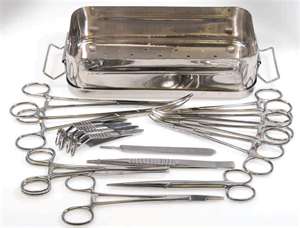Using an Ultrasonic Cleaner in the Animal Hospital

Veterinary surgeons in animal hospitals and veterinary clinics will quickly see the benefits of using an ultrasonic cleaner to thoroughly remove blood and tissue from veterinary equipment such as knives, probes, curettes, trimmers and pipettes. The ultrasonic cleaning process is fast and much safer than hand scrubbing surgical instruments because it reduces the potential risk of staff injury and damage to sharp edges.
How it Works
An ultrasonic cleaner operates on the principal of cavitation – the action of billions of minute bubbles imploding on the surface of objects immersed in the ultrasonic cleaning solution. These bubbles are created by generator-powered ultrasonic transducers mounted on the cleaner’s tank and can reach the tiniest cracks, crevices and blind holes in the instruments to blast away contaminants without damaging delicate surfaces.
Units such as the 1.8-gallon capacity Elmasonic S70H and 3.75-gallon capacity Elmasonic S150 available from Tovatech can clean instruments up to 18 inches long. Both operate at 37 kHz ultrasonic frequency, which is ideal for this application, and both offer a degassing mode.
A Typical Cleaning Procedure
Always follow manufacturers’ instructions. Remove gross contamination from the veterinary equipment before the ultrasonic cleaning process.
- Fill the ultrasonic cleaning tank with an approved medical instrument cleaning solution such as MedClean C7 available from Tovatech following dilution instructions provided. Turn the unit on and activate the degas mode to drive off cavitation-inhibiting entrained air. If the unit does not have a degas mode, operate it without a load for about 45 minutes. When bubbles stop rising to the surface the solution is ready for the cleaning operation.
- Segregate medical instruments by alloy and place them in the provided tray taking care that they do not touch each other.
- Lower the tray into the ultrasonic bath and set the timer for 5 minutes or according to instructions.
- At the end of the cycle thoroughly rinse the instruments to remove all traces of the cleaning solution. Deionized or distilled water will avoid water spotting. Instruments are now ready for disinfecting or sterilizing in accordance with standard veterinarian practice.
You should have written procedures guiding the replacement of cleaning solutions and cleaning the tank. Remember that new solutions must be degassed before starting the ultrasonic cleaning process.
In summary, faster, safer cleaning and longer instrument life are among the benefits of using ultrasonic energy as a cleaning process in an animal hospital and veterinary clinic. Contact the ultrasonic cleaning experts at Tovatech for more details on cleaning surgical instruments.
How do you clean surgical instruments in your veterinary practice?
